
Tigger is a fictional character in A.A. Milne's Winnie-the-Pooh books and their adaptations; an anthropomorphic toy tiger. He was originally introduced in the 1928 story collection The House at Pooh Corner, the sequel to the 1926 book Winnie-the-Pooh by A. A. Milne. Like other Pooh characters, Tigger is based on one of Christopher Robin Milne's stuffed toy animals. He appears in the Disney animated versions of Winnie the Pooh and has also appeared in his own film, The Tigger Movie (2000).

Eeyore is a fictional character in the Winnie-the-Pooh books by A. A. Milne. He is generally characterized as a pessimistic, gloomy, depressed, anhedonic, old grey stuffed donkey who is a friend of the title character, Winnie-the-Pooh.

A Heffalump is an elephant-like creature in the Winnie-the-Pooh stories by A. A. Milne. Heffalumps are mentioned, and only appear, in Pooh and Piglet's dreams in Winnie-the-Pooh (1926), and are seen again in The House at Pooh Corner (1928). Physically, they resemble elephants; E. H. Shepard's illustration shows an Indian elephant. They are later featured in the animated television series The New Adventures of Winnie the Pooh (1988–1991), followed by two animated films in 2005, Pooh's Heffalump Movie and Pooh's Heffalump Halloween Movie.
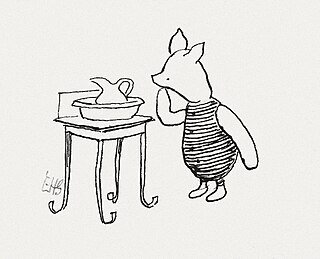
Piglet is a fictional character from A. A. Milne's Winnie-the-Pooh books. Piglet is Winnie‑the‑Pooh's closest friend amongst all the toys and animals featured in the stories. Although he is a "Very Small Animal" of a generally timid disposition, he tries to be brave and on occasion conquers his fears.

The Tigger Movie is a 2000 American animated musical comedy-drama film produced by Walt Disney Television Animation with animation production by Walt Disney Animation (Japan), Inc., written and directed by Jun Falkenstein from a story by Eddie Guzelian, and released by Walt Disney Pictures on February 11, 2000. It is the second theatrical Winnie the Pooh film after The Many Adventures of Winnie the Pooh and features Pooh's sidekick Tigger as the main protagonist searching for his family tree and other Tiggers like himself. The film was the first feature-length theatrical Pooh film that was not a collection of previously released shorts.

Piglet's Big Movie is a 2003 American animated musical adventure comedy-drama film released by Walt Disney Pictures on March 21, 2003. The film features the characters from the Winnie-the-Pooh books written by A. A. Milne and E. H. Shepard and is the third theatrically released Winnie the Pooh feature. In this film, Piglet is ashamed of being small and clumsy and wanders off into the Hundred Acre Wood, leading all of his friends to form a search party to find him.
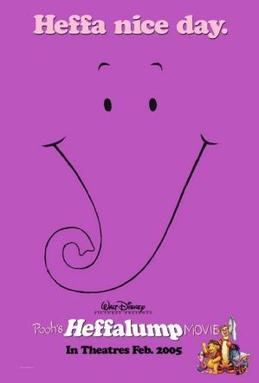
Pooh's Heffalump Movie is a 2005 American animated musical adventure comedy-drama film produced by the Japanese office of Disneytoon Studios and released by Walt Disney Pictures. Featuring characters from A. A. Milne's Winnie-the-Pooh stories, the film is the fourth theatrical animated film in Disney's Winnie the Pooh franchise and DisneyToon Studios's third adaptation of Winnie the Pooh stories, following The Tigger Movie (2000) and Piglet's Big Movie (2003). The film was released theatrically on February 11, 2005. The film was followed by a direct-to-video Halloween sequel titled Pooh's Heffalump Halloween Movie which came out seven months after the film's release.

The Book of Pooh is an American children's television series that aired on the Playhouse Disney block on Disney Channel. It is the third television series to feature the characters from the Disney franchise based on A. A. Milne's works; the other two were the live action Welcome to Pooh Corner and the animated The New Adventures of Winnie the Pooh which ran from 1988 to 1991. It premiered on January 22, 2001 and completed its run on July 8, 2003. It was repeated on Playhouse Disney until June 2, 2006. The show is produced by Shadow Projects. Walt Disney Pictures released the first of two films, a direct-to-video spin-off film based on the puppetry television series titled The Book of Pooh: Stories from the Heart in 2001.
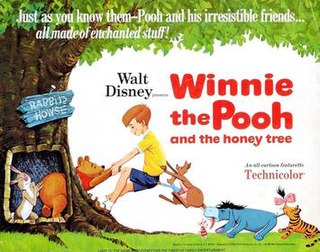
Winnie the Pooh and the Honey Tree is a 1966 American animated featurette based on the first two chapters of Winnie-the-Pooh by A. A. Milne. The film was produced by Walt Disney Productions, and released by Buena Vista Distribution on February 4, 1966, as a double feature with The Ugly Dachshund. It was the last short film produced by Walt Disney, who died of lung cancer on December 15, 1966, ten months after its release. Its songs were written by the Sherman Brothers and the score was composed and conducted by Buddy Baker.

Winnie the Pooh and the Blustery Day is a 1968 American animated featurette based on the third, fifth, ninth, and tenth chapters of Winnie-the-Pooh and the second, eighth, and ninth chapters from The House at Pooh Corner by A. A. Milne. The featurette was directed by Wolfgang Reitherman, produced by Walt Disney Productions and released by Buena Vista Distribution Company on December 20, 1968, being shown in theaters with The Horse in the Gray Flannel Suit. This was the second of the studio's Winnie the Pooh theatrical featurettes. It was later added as a segment to the 1977 film The Many Adventures of Winnie the Pooh. The music was written by Richard M. Sherman and Robert B. Sherman. It was notable for being the last Disney animated short to be produced by Walt Disney, who died of lung cancer on December 15, 1966, two years before its release.

Winnie the Pooh and Tigger Too is a 1974 American animated featurette based on the third chapter of Winnie-the-Pooh and the fourth and seventh chapters of The House at Pooh Corner by A. A. Milne. The featurette was directed by John Lounsbery, produced by Wolfgang Reitherman, released by Walt Disney Productions, and distributed by Buena Vista Distribution. It was released on October 21, 1974, and released again as a double feature on December 20, 1974, with the live-action feature film The Island at the Top of the World. It was nominated for an Academy Award for Best Animated Short Film, but lost to Closed Mondays.

Pooh's Grand Adventure: The Search for Christopher Robin is a 1997 American direct-to-video animated musical adventure comedy-drama film co-written, co-produced, and directed by Karl Geurs. The film follows Pooh and his friends on a journey to find and rescue their friend Christopher Robin from the skull. Along the way, the group confront their own insecurities throughout the search, facing and conquering them in a series of events where they are forced to act beyond their own known limits, thus discovering their true potential. Unlike the film's predecessors, this film is an entirely original story, not based on any of A. A. Milne's classic stories.

Winnie the Pooh and a Day for Eeyore is a 1983 American animated featurette based on the sixth chapter of both books Winnie-the-Pooh and The House at Pooh Corner by A.A. Milne. Produced by Walt Disney Productions and distributed by Buena Vista Distribution, the short initially received limited release on March 11, 1983, before expanding to a wide release on March 25 as part of a double feature with the re-issue of The Sword in the Stone (1963), which it accompanied in most countries except Australia where it accompanied a reissue of Bedknobs and Broomsticks (1971). Directed by Rick Reinert, the featurette featured the voices of Hal Smith, John Fiedler, Will Ryan, Ralph Wright, and Paul Winchell.
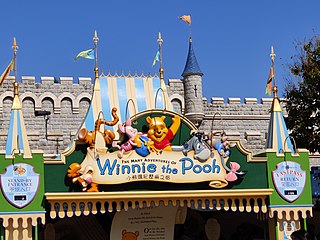
The Many Adventures of Winnie the Pooh is a dark ride based upon the 1977 film of the same name, itself based on the Winnie-the-Pooh books by A. A. Milne. The attraction exists in slightly different forms at the Magic Kingdom in the Walt Disney World Resort, Disneyland, Hong Kong Disneyland, and Shanghai Disneyland Park. Pooh's Hunny Hunt, located in Tokyo Disneyland, is an enhanced "E-ticket class" attraction, featuring full audio animatronics and a trackless ride system.

A Very Merry Pooh Year is a 2002 American direct-to-video Christmas animated musical film produced by Walt Disney Television Animation. The film features the 1991 Christmas television special Winnie the Pooh and Christmas Too, as well as a new film, Happy Pooh Year. The film animation production was done by Wang Film Productions Co., Ltd., and Sunwoo Animation, (Korea) Co., Ltd.

Winnie the Pooh is a fictional bear and the main character in Disney's Winnie the Pooh franchise, based on the character Winnie-the-Pooh created by English author A. A. Milne and English artist and book illustrator E. H. Shepard, being one of the most popular characters adapted for film and television by The Walt Disney Company. Disney first received certain licensing rights to the Winnie-the-Pooh stories, characters, and trademarks from Stephen Slesinger, Inc. and the estate of A. A. Milne in 1961. Winnie the Pooh is one of the most popular characters adapted for film and one of Disney's most popular characters, especially in terms of merchandising.

Winnie the Pooh and Christmas Too is a 1991 Christmas television special based on the Disney television series The New Adventures of Winnie the Pooh, originally broadcast on December 14, 1991, on ABC and produced by Walt Disney Animation (France), S.A. and Walt Disney Television Animation.

Winnie the Pooh: A Valentine for You is a Valentine's Day special based on A. A. Milne's stories, originally broadcast on ABC on February 13, 1999. A Valentine for You was released on VHS in 2000, 2001, and 2002, and on DVD in 2004 and 2010. It was made available for streaming on Disney+ on February 11, 2022.
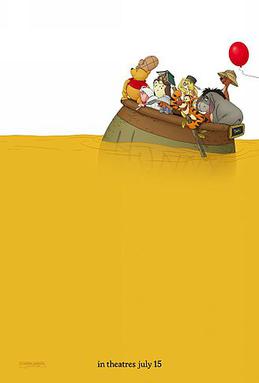
Winnie the Pooh is a 2011 American animated musical comedy film produced by Walt Disney Animation Studios and released by Walt Disney Pictures. It is based on the book series of the same name written by A. A. Milne and illustrated by E. H. Shepard. The film is a revival of Disney's Winnie the Pooh franchise and the fifth theatrical Winnie the Pooh film released, and the second in the Disney Animated Canon. It was directed by Stephen Anderson and Don Hall, and produced by Peter Del Vecho and Clark Spencer, based on a story that Anderson and Hall conceived with Clio Chiang, Don Dougherty, Kendelle Hoyer, Brian Kesinger, Nicole Mitchell, and Jeremy Spears.
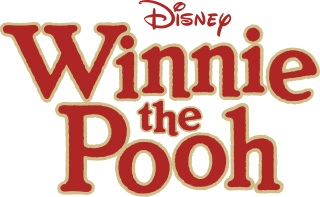
Winnie the Pooh is a media franchise produced by The Walt Disney Company, based on A. A. Milne and E. H. Shepard's stories featuring Winnie-the-Pooh. It started in 1966 with the theatrical release of the short Winnie the Pooh and the Honey Tree.




















